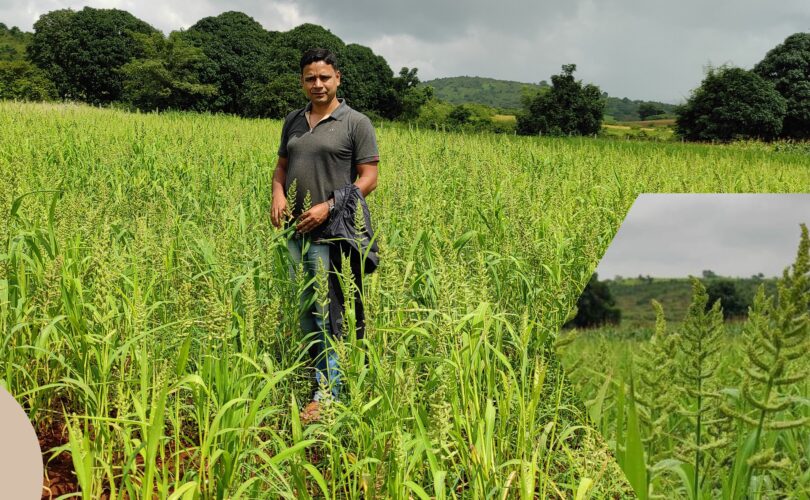Barnyard Millet (Echinochloa frumentacea) holds a special place in India’s agricultural landscape, serving as both a minor cereal crop for food and a valuable fodder resource. While this millet is predominantly grown in states like Uttarakhand, Uttar Pradesh, Karnataka, Tamil Nadu, Andhra Pradesh, Bihar, Gujarat, Chattisgarh, and Madhya Pradesh, its cultivation in Odisha remains relatively unexplored. In this article, I will share my experiences and insights from a trial I conducted on Barnyard Millet in the region, highlighting the potential for crop diversification and dietary enrichment it offers.
Health Benefits of Barnyard Millet:
Barnyard Millet is gaining recognition as a health food due to its rich nutritional profile, high dietary fiber content, and essential nutrients such as iron, calcium, magnesium, and zinc. With 15.2mg of iron per 100 grams, 10.1 grams of crude fiber, 11.2 grams of proteins, and 4.4 grams of minerals, this millet provides a valuable source of nourishment. Additionally, it contains essential amino acids like lysine, cysteine, and isoleucine. Its low glycemic index (GI) makes it a suitable choice for individuals with diabetes, and it is recommended for infants and pregnant women.
Local Names of Barnyard Millet:
- Hindi: Sanwa, Jhangora
- Telugu: Udalu, Kodisama
- Tamil: Kuthiraivalli
- Kannada: Oodalu
- Malayalam: Kavadapallu
- Odia: Khira
- Punjabi: Swank
Soil and Climate Requirements:
Barnyard Millet thrives in loam or sandy loam soil with adequate organic matter content. It exhibits robust growth with an annual rainfall ranging between 500-700 mm. This versatile crop is tolerant of varying temperatures and can even be cultivated at altitudes of up to 2700 meters.
Package of Practices:
To ensure successful Barnyard Millet cultivation, it is essential to follow recommended practices:
- Seed Rate: For line sowing, use 8-10 kg/ha, and for broadcasting, use 12-15 kg/ha.
- Spacing: Maintain a spacing of 30 cm x 10 cm.
- Depth of Sowing: Plant seeds at a depth of 2-3 cm.
- Time of Sowing: Optimal sowing periods are Kharif (mid-June to 1st week of July), Rabi (September to October), and Summer (January to March).
- Fertilizer: Apply 2 tons of manure and 500 kg of vermicompost per acre. Utilize Jeevamrit three times during the crop’s growth.
- Seed Treatment: Implement appropriate seed treatment methods.
- Critical Irrigation: Provide irrigation at 25-30 days after sowing and again at 45-50 days for optimal growth.
My Barnyard Millet Experiment:
My journey with Barnyard Millet began with little prior experience of seeing it grow in Koraput, Odisha. I embarked on this experimental journey, following recommended practices meticulously, and I am grateful to the Agriculture Research Station in Vizianagaram for providing me with the VMBC-331 variety of seeds.
The seeds were treated with Beejamrit to safeguard against diseases. I transplanted 27-day-old seedlings in rows, maintaining a spacing of 10 inches. At planting, vermicompost was applied as a basal dose. Since organic cultivation was adopted, Jeevamrit was regularly sprayed at 20-day intervals.
Weed management proved to be a significant challenge, but we efficiently used a cycle weeder to save time and labor. Weeding was performed twice, at 25 and 40 days after transplanting, a crucial practice for optimizing yield.
For irrigation, Barnyard Millet typically requires minimal water during the Kharif season. However, during dry spells, two irrigations—one at 25-30 days after sowing and another at the panicle initiation stage (45-50 days after sowing)—are recommended to ensure better yields.
Thankfully, my experiment encountered no major disease issues, but vigilance against Smut diseases at various growth stages is essential. Potential pests include Shoot fly, Stem Borer, and termites during the seedling stage.
Lessons Learned:
During the seedling stage, I faced a termite infestation, which can be devastating to young seedlings. To mitigate this, I used Neem Oil-1500 ppm at a rate of 5 ml per liter and properly drenched the soil to protect against termites.
When seedlings exceed 25 days, planting two seedlings per hill is recommended for higher yields compared to single seeding.
My experiment yielded promising results, demonstrating that Barnyard Millet can indeed be cultivated in Odisha. This opens up new opportunities for local farmers to diversify their crops and potentially increase their income.
Conclusion and Promotion:
I am enthusiastic about promoting millets from farm to plate through my YouTube channel and blogs. If you’re interested in learning more about my experiences and agricultural insights, consider subscribing to my channel.
Barnyard Millet has the potential to not only enhance crop diversity but also contribute to improved dietary choices for individuals in Odisha and beyond. Exploring and embracing such crops can pave the way for a more sustainable and nutritious future in agriculture.


